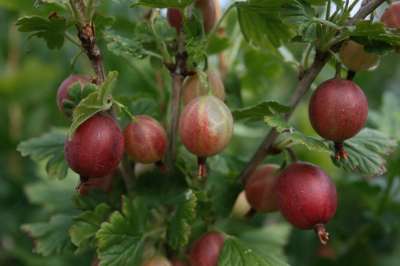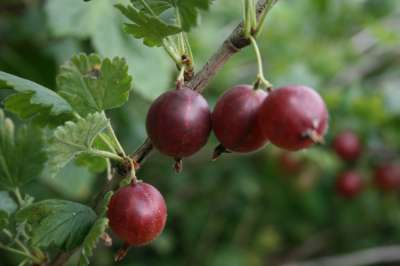Your basket is currently empty!
GREAT FRUITITING CLIMBERS AND VINES FOR WALL, TRELLIS ARCH & PERGOLA
When considering utilizing that valuable vertical space in your garden there is a wide range of productive climbers you may consider to add value and productivity to your garden. Be it sun or shade there are choices which will thrive and prove a valued investment. Here’s a summary of what to plant where.
The sunny aspect
South or west facing is a great environment for warmth loving vines such as Grape, Fig and Kiwi. Most soils are suitable just remember that getting so much sun, and with the added protection from rainfall it is important to make sure the soil isn’t too dry. In those conditions advance preparation is key with the addition of copious amounts of moisture retentive organic matter such as compost, leafmould and lawn clippings. An added mulch after planting is also very beneficial. The above do tend to be more drought tolerant once established but regular watering following planting will help them get their roots down. It is also worth remembering that as they mature and reach greater productivity extra irrigation during drier periods will not only increase the yield, but also the size and sweetness of the crop.
The shady North or East facing structure
Hardiness and an ability to ripen with less sunshine are the key attributes required and happily all blackberry, hybrid berry and hop vine will thrive and can be used in these aspects that would be unsuitable for a lot of non productive ornamental vines and climbers. As North and East facing walls, fence, trellis and arbour tend to be less prone to drying out upkeep is also minimal except for basic pruning and tying in.
Spacing
Is largely down to how they are to be grown; climbers in particular – such as hop vine, grape and kiwi – tend to travel as far as you will let them but they will need training and tying in so really it’s a matter of affording them available space and then trimming back which does them no harm at all.
With lax cane growing subjects such as the blackberries, hybrid berry and tayberry or loganberry they are better with the space of a wall of around 8’ but they can also be grown on single posts such as that of a pergola and tied in.
When to Plant
All of the subjects mentioned in this article will be supplied in containers so you can get cracking at any time of the year. Autumn and Winter is often considered the better time as they don’t receive any check or shock following planting. And aside from watering in after planting to settle the soil around the roots they will generally need no more than that.
Summer planting is also fine and they tend to establish and grow away quite quickly but remember that daily watering for the first couple of weeks is important; and thereafter once every few days until well established.
Pruning and training
Blackberries, Tayberry, Loganberry and Hybrids
These are not specifically climbers but they are lax in growth, requiring support which is why they are ideal for wall and structure. The canes should be tied in as they grow. Pruning is carried out on an annual basis with the removal of all fruited growth at the base of the plant in Autumn. The resulting strong growths from the base should be tied in. All longer canes can be tipped back if required later in the Summer.
Kiwi Vines
These can be quite vigorous, especially in a warm sunny spot, they twine rather than cling by tendril so they do need to be ‘shown’ the support and tied in if necessary with soft twine or rubber coated ties. No pruning is necessary except the removal of dead shoots in Spring but this shouldn’t be undertaken too early as they are generally quite late coming into growth.
Figs
Really require no pruning except the removal of dead wood as the plant ages. They can be pruned a little to keep them in check. It is important to only do this during the dormant winter period as cut growth will ‘bleed’ a milky white sap when in growth. They are self supporting and quite easy to tie in to a structure initially.
Grape Vines
There are many different ways of training vines – please see our complete guide on growing grape vines. These vines have tendrils so once they are encouraged on to a support they can generally make their own way. Pruning over winter to keep them within bounds is fine.
Hop Vines
Pruning is very simple – as all growth will die away completely in late Autumn simply cut away all of it at the base of the plant at some point over winter to allow the strong new growths to grow in the Spring. Often these can be seen in late winter as fat buds waiting to grow out from the very base of the plant. These cling by twining so initial help should be given by tying in new growths once long enough. Keep an idea on them as they grow as they are quite enthusiastic and can wander from the support and become lax so it’s worth checking in on them periodically during the summer to keep them tidy.
TWELVE RECOMMENDED FRUITING PLANTS AND VINES FOR YOUR GARDEN
12] Loganberry The best strain is ‘LY654’ as it is smooth in growth with no prickles and also yields well with characteristic light purple fruits. Grow as you would a Blackberry. The fruits are great eaten straight from the plant but also make very flavourful jams and also freeze well. Make sure they are a uniform deep purple before using them otherwise they can be quite tart but fully ripe have a rich, moreish flavour.
11] Grape ‘Theresa’ A newer variety from Germany which has the advantage of being hardier and is also mildew resistant. The fruits are quite large, especially when thinned, and are a pale whitish green, Suits dual purpose use – a very good grower which quickly covers most areas.
A species in the Blackberry family known as Rubus phoeniciolasus. This has the advantage of being quite attractive as well as unusual. The rounded vermillion red berries ripen in July and are quite a delicacy for dessert use with a gentle sweet piquancy. The leaves tend to be quite light and almost yellow and deeply veined, although they take on a darker hue when grown in the shade to which it is well suited. The main stems are bristly rather than thorny and quite red and fuzzy in appearance and this plant also has good Autumn leaf colour.
9] The Hop Vine
Not a true fruiting vine of course but the young shoots can be eaten lightly steamed and the hops themselves are of famously used in brewing as well as dried and brought in to the house as ornamental garlands so this one definitely has it’s uses! The leaves turn yellow in Autumn. This is a strong growing twining vine that dies right back to ground in winter, producing strong annual growth from a perennial rootstock, able to cover most areas in a single season.
Also known as the Strawberry Vine owing to it’s sweet and subtle strawberry-like flavour. Best used for dessert, the berries ripen from late September on a vine of moderate vigour which suits any sunny aspect. A real speciality and well worth including in your plans!
Figs are not climbers or twiners but almost invariably do best trained in a sunny warm aspect and are quite easy to bend to your will. Brown Turkey is by far the most famous variety and with good reason as it is the hardiest and most reliable. The plump pear shaped fruits have a juicy dark purple flesh and ripen over a long period. Figs are very decorative with large lobed leaves. They actually prefer a poorer soil and the hotter the better! Othe varieties to consider are the large fruits ‘Brunswick’ and super-sweet, paler ‘White Marseilles’
A thornless variety which is of great use if the area is one that is heavily used as you don’t want to be scratched to bits every time you pass. Helen is one of the earliest to ripen with decent sized ebony fruits of good flavour. In common with all Blackberries it will thrive in sun or shade alike. A newer variety.
A hybrid between a Blackberry and Raspberry and a real stunner capable of producing a wealth of large, long claret purple fruits. The flavour is intense and aromatic – suiting fresh eating or pies and jams. It does have prickles but not like bayonets. Easy to grow and hugely impressive when in fruit. Medana is the best strain.
Very useful where space is limited as it is more compact than most yet still produces a better than worthwhile crop. It is thorn free and easy to grow and train. Now our most popular Blackberry.
3] Grape Vine ‘Brandt’ A real outdoor specialist which doubles as a productive and ornamental vine as the large leaves have decorous Autumn foliage tints dappled amongst the mass display of dark blue-black fruits which ripen in the Autumn. Can be made into wine or eaten fresh, this variety is also recommended where the leaves are required for stuffing in Greek cuisine.
2] Blackberry Oregon Thornless
Again more than earns it’s keep through looks as well as yield. Sometimes known as the parsley leafed blackberry because the foliage is finely cut and delicate in appearance. The rounded glossy black fruits ripen through July and have a good sweet flavour. Thorn free growth and a very pleasing variety to grow.
1] Kiwi Vine ‘Jenny’ Most Chinese Gooseberries have to be grown in pairs for pollination purposes but Kenny is auto self fertile so it will crop well on it’s own. Kiwi Vines are a joy in any warmer sunny spot as the velvety right emerald green leaves and fuzzy red stems are such a visual joy. The fruits should be harvested in October and ripened on a window sill. If you have room for two or more vines then you can plant up to three females – Hayward and Bruno are the best – with one male such as the variety ‘Atlas’.
Hopefully this article has inspired you to make the most of any vertical space you may have spare, or maybe to change what you already have planted to something that gives a bit more back than that ubiquitous black spot infested rose or tired Pyracantha!






